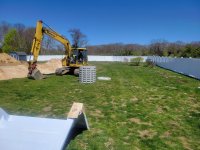- Jul 15, 2012
- 613
- Pool Size
- 30
- Surface
- Plaster
- Chlorine
- Salt Water Generator
- SWG Type
- Hayward Aqua Rite (T-15)
I have owned and used my pool since 2001 and until last year had it serviced by a professional company. Since last summer, I have maintained the pool myself. When I change my DE filter, I put the unit in backwash and let the DE drain through the waste line into a buried drywall near my equipment buried underground. Seemed to work no problem.
This year I refinished my pool and have been changing the DE daily as the dust gets cleared. Last night I noticed the ground near the pool is seating upward and I believe it is from DE drainage. I am not sure how to address. I suppose I need to dig up the are to see what is going on. But what is the best way to dispose of the DE in my yard? And how do I handle large volumes on occasion like right now? I am guessing the DE has clogged whatever drywall I have underground. I have no idea of its size.
This year I refinished my pool and have been changing the DE daily as the dust gets cleared. Last night I noticed the ground near the pool is seating upward and I believe it is from DE drainage. I am not sure how to address. I suppose I need to dig up the are to see what is going on. But what is the best way to dispose of the DE in my yard? And how do I handle large volumes on occasion like right now? I am guessing the DE has clogged whatever drywall I have underground. I have no idea of its size.



 it's just muddy water ...
it's just muddy water ...